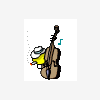Search the Community
Showing results for tags 'analysis'.
-
chorale How do I write a harmonic analysis of a chorale?
DailyDuo posted a topic in Advice and Techniques
Dear composers, I have to write a harmonic analysis of Bach's BWV 4 (Christ lag in Todesbanden) - Versus 7 for my homework Here is the link: https://www.youtube.com/watch?v=ubWCRXefVTw I have knowledge of harmony and chord analysis with Roman numerals. How can I write a harmonic analysis? Could you please give me some tips? Thanks in advance, Duo -
The answers to some of the questions are on the bottom of this post. Italicized questions should get a short writing response (a sentence or two) along with the composition portion. 1. View the attached score and listen to a recording. 2. The first step when analyzing a piece is to discern its form. Attempt to discern the parts. Then, look for how many phrases are used in each section. What makes a section more similar or dissimilar to another? 3a. The whole step interval (G & A) bounced around the bottom of page two breaks the obvious pattern. Same with the final Piú mosso section. Why would he write it like this? Obviously it's not simply to sound "cool". 3b. Do the non-A sections have any relation to themselves? To the A sections? If so, what is it? If not, why would we write it like this? 4. In almost every section, the pitches do not fall into any pre-established scale. This is because this piece utilizes intervallic mirror technique, where the pitches are reflected exactly upon a tonic note. Your task is to find all the places where this reflection is either shifted or inexact in some way. Ponder why he would bother doing this. 5. Write a short piece for solo piano using mirroring and a recurring A section with changes. Your piece should include a process, that is, a theme of continuously changing something in the piece by a some fixed amount, linear or exponential. 2. Systems 1-3: A Systems 3-4: B Systems: 4-5: A Systems 5-7: B' Systems 7-8: A System 9-10: B" System: 10-11: C Systems 11-13: A Systems 13-15: D (What's important here is that the A sections sound similar, but the other sections do not show any obvious similarities to considered like sections) 4. Mirror off an eighth note in second and third A. The fourth A section gradually displaces the mirror by eighth note, and changes the intervals of the left hand several times, most noticeably the E natural in the beginning. D uses a separate kind of thrown off mirror system.
-
Hello! Can you guys help me to figure out what harmonies are used in bar 4th, 16th and 36th? music sheet audio This is the full analysis if you want to check it as well (question marks where I couldn't identify the harmony) F dorian mode A bar 1 to 12: I - I - V35 - ? x4 B (bar 17 to 32) I46 - IV7 - VII46 - V46 x4 but bar 32: VII36 C bar 33 to 44: IV46 - IV34 - III - ? x3 bar 45 to 48: II - II - IV34 - IV46 Thank you!
-
Hello, i have some troubles with the definitions codetta, extension and episode. I need to know how to construct these topics in a scherzo or minuet Also, i need to see examples of literature that show me concretely this things Thanks.
- 2 replies
-
- composicion
- forms
-
(and 1 more)
Tagged with:
-
Hi All, I have trouble with writing larger/longer pieces of music. I can come up with melodies or "riffs", but I'm not sure how to make a piece "coherent" and not simply a string of ideas, or a "song", or ABA form. To help me understand, I would like to start with a very simple and short example, prelude in C by Bach, BWv924 (see attached). Why is this piece "coherent"? What is the structure or form of this piece? Thanks for any help IMSLP222728-PMLP180599-Bach_Prelude_BWV924_Cmaj.pdf
- 9 replies
-
- composition
- coherence
-
(and 2 more)
Tagged with:
-
Fair warning: this post might get a bit technical. I really like thinking about music theory, but I don't know very many people I can discuss it with. Some time back, I came across the following website, which really changed the way I think about harmony and its relation to musical structure (we're talking mostly tonal CPP music). I'm wondering whether anyone else has seen this before, or is interested in taking a look at it. The site is www.harmony.org.uk by Tom Sutcliffe. It outlines a thesis he has developed (and a corresponding unfinished ebook, Syntactic Structures in Music) which loosely compares musical phrases to linguistic phrases, and shows how they are built up from two distinct types of harmony, which he calls static and dynamic harmony. It's based on a root progression analysis, and also incorporates some ideas from Schenker. At the very least, it's worth reading the Preface and Chapters 1 and 2 in the book to get the basic gist of the theory. You could also read through the outline thesis to see a sample analysis, and how the idea was developed. Here's my attempt to summarize his theory: First, the harmonic analysis proceeds in a fairly standard manner: - Reduce the music to it's harmonic outline by stripping out non-chord tones (which arise from voice leading effects), and chords which are produced from non-chord tones (non-functional chords). For example, cadential 6-4 chords are formed from appoggiaturas, so they would be non-functional. He attempts to be very specific about what is non-functional. - Categorize the motion of the roots of the resulting chords in terms rising and falling diatonic intervals (e.g. rising fourth, falling third). Because chord progressions are chiefly a diatonic phenomenon, the quality of the interval is not considered (e.g. major vs minor third). This means there are only a total of 6 possible progressions. - The quality of the chord (major, minor, diminished, 7ths, 9ths, etc...) is also ignored. Only the root progression is analyzed. Several observations were made from this analysis: - Sometimes root progressions come in "pairs" of opposite types (e.g. a falling fourth followed by a rising fourth), while other progressions are unpaired. - These two types of progressions (paired and unpaired) have a strong tendency to "cluster" with others of the same type. That is, paired progressions are often adjacent to other paired progressions, and unpaired progressions are almost always adjacent to other unpaired progressions. This clustering allows us to segment the music, and suggests that music is built out of two distinct types of harmony: - "Static Harmony" - sections consisting of paired progressions which oscillate around a central chord (usually the tonic, though dominant could also be used). - "Dynamic Harmony" - sections consisting of unpaired progressions which have a stronger sense of forward harmonic motion. A few additional observations can be made: - Statistically, the progressions used in Dynamic Harmony have become polarized, such that they consist almost entirely of the following three progressions, which he names after greek letters: - "Alpha" (α) - A rising 4th. By far the most common (e.g. ii-V and V-I). - "Beta" (β) - A falling 3rd (e.g. I-vi). - "Gamma" (γ) - A rising 2nd (e.g. IV-V). - The remaining 3 progressions are much rarer, and are named after their inverse, followed by a prime symbol (e.g. a rising third would be a beta-prime (β') progression). - Musical phrases (sections delimited by cadences) tend, in general, to follow some variation of the following pattern: begin with static harmony, followed by dynamic harmony, and ending in a cadence. He then compares musical phrases to linguistic phrases, and postulates that static and dynamic harmony, and cadences are the syntactic "building blocks" of musical phrases, much like subject and predicate are the building blocks of linguistic phrases. Of course, the book goes into greater detail.
- 4 replies
-
- music theory
- analysis
-
(and 1 more)
Tagged with:
-
Hello everyone! I'm trying to compose once again. Here is this very innocuous, exercise-like composition I made for the piano. Audio here: untitled.mp3 What I would like to ask is this. How would you describe this composition? Does it make "sense" to you, in the purely musical sense? Could it be better, perhaps? And lastly, what criticism or feedback could you give (e.g., the second to last bar has a figuration which sucks, etc.)? Anything will do, even mean comments. (P.S.: Is this the right forum to post this in?)
-
hi, i'm trying to analyze a song so to better understand my options when writing some music. i know some stuff about harmony but i'm in an early stage and get stuck when i try to define the functions ... ... would be amazing if someone could meet me online vie skype for a little session to go over a song together, so i get a grip how to do it. Regards, Frank
-
... harmonically and contrapuntally (and ignore the orchestration - except maybe where it becomes a factor in eliminating repetition or something else that's permitted because it's orchestrated that wouldn't be okay in some other contexts), is my best bet to get a piano arrangement from, say, IMSLP and study that?









